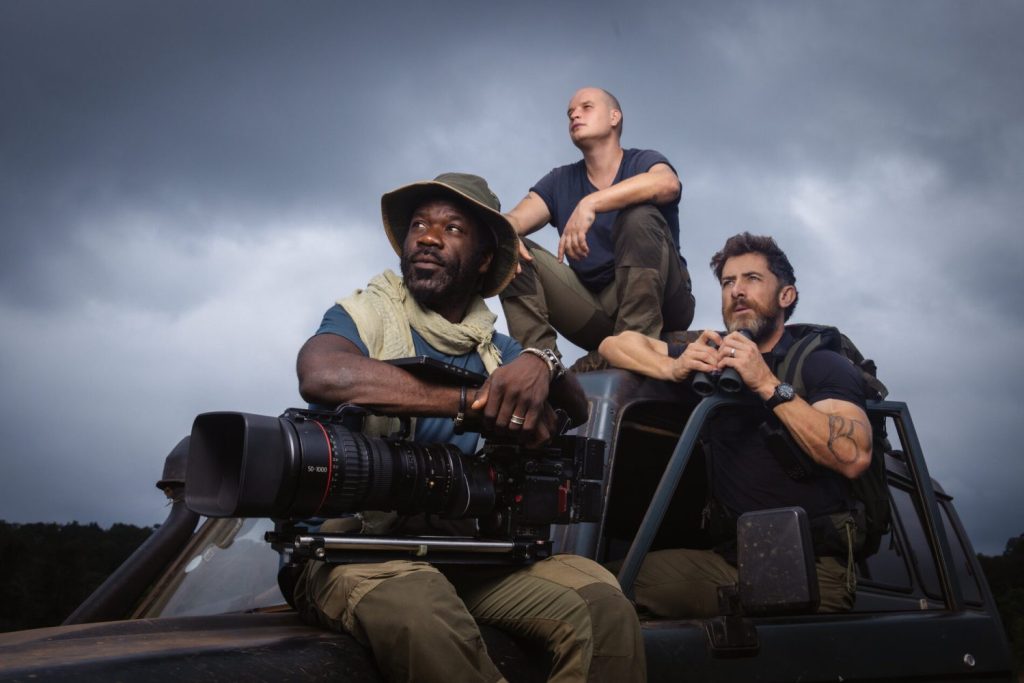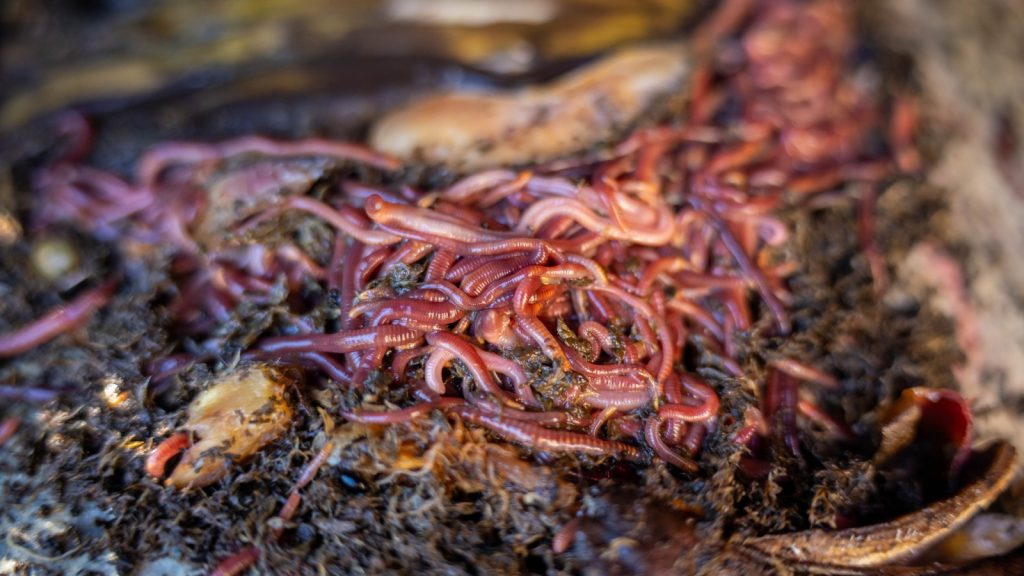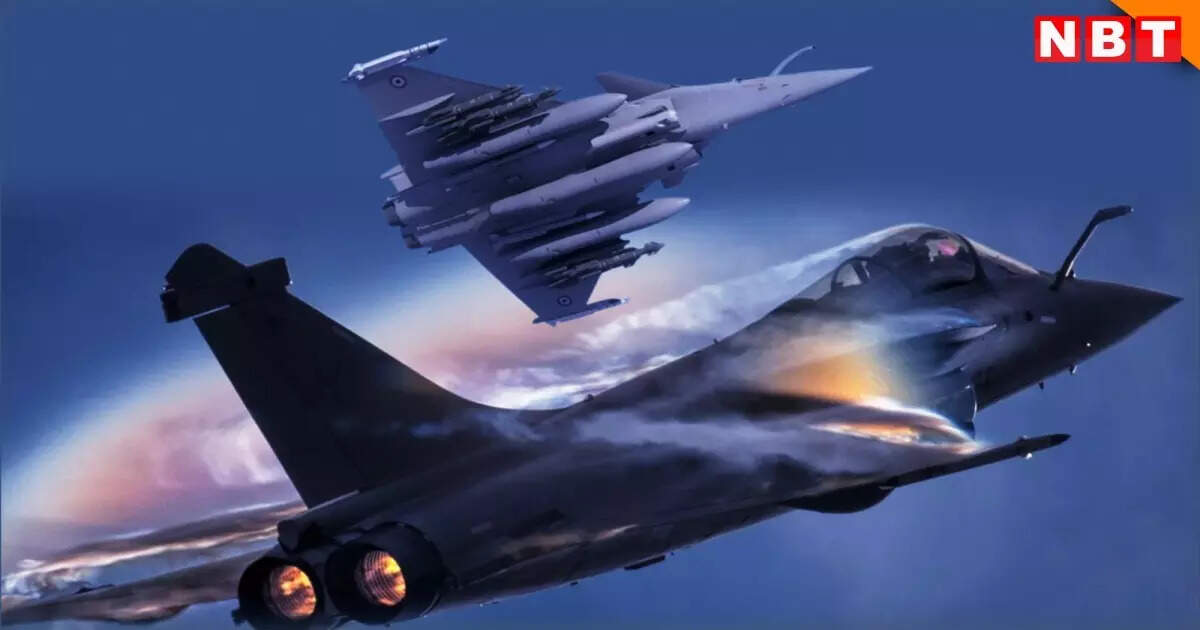Now Reading: Australia has an absurdly huge feral camel problem
-
01
Australia has an absurdly huge feral camel problem
Australia has an absurdly huge feral camel problem
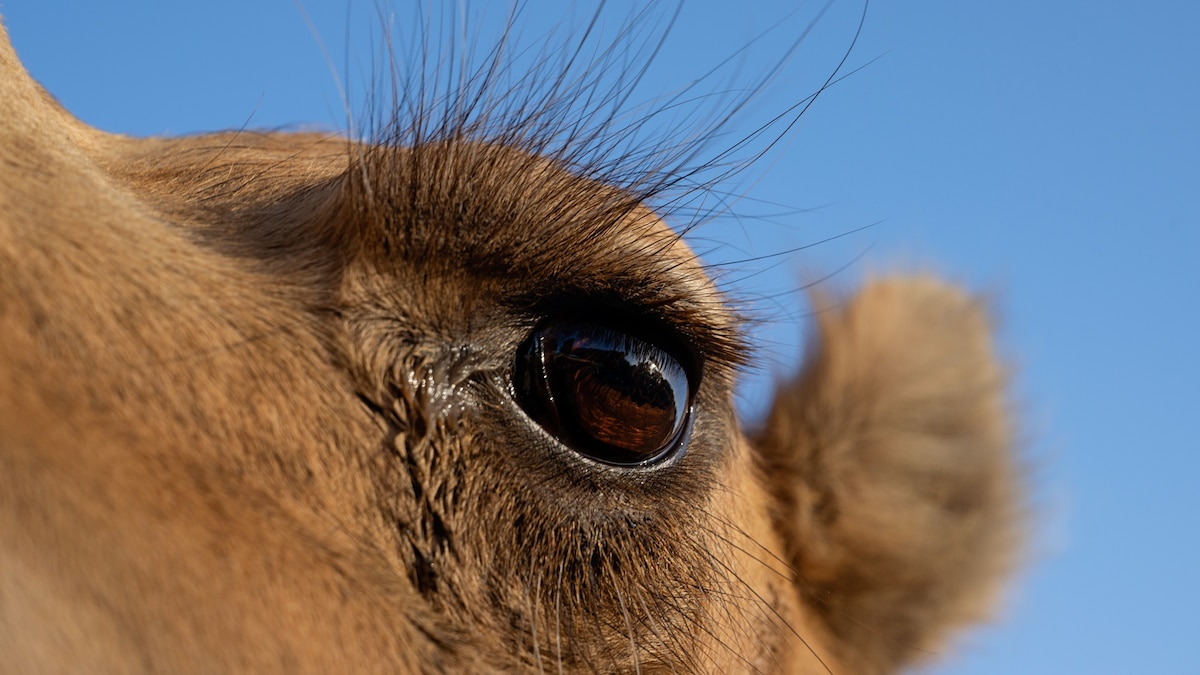
BySean Williams
Photographs byMatthew Abbott
Jack Carmody has built a sizable YouTube following by showing his viewers what it takes to run a cattle station in the Australian outback—the rugged work of mending troughs, reinforcing fences, and shooting trespassers. Feral horses and donkeys, that is, and one particularly destructive invasive species: camels. Introduced in the 19th century to help colonists survey the country’s vast interior, the creatures are now wreaking havoc across the outback and decimating the Carmody family’s ranch property, or what Australians call a cattle station. At more than 1,500 square miles, the property—Prenti Downs—is the size of Rhode Island, so there’s plenty of work to be done, and in this modern internet age, there’s plenty of content to be created.
On Carmody’s channel, Jack Out The Back, no videos are more popular than those focused on his fight against the camels, which the straight-talking father of three culls with his rifle, taking out nearly 800 each year. The approach might seem alarming, but to Carmody and other cattle farmers, it’s simply the most rational solution to a dire problem, “like weeding the veggie patch,” as he puts it. And in a twist that is perhaps good for YouTube and bad for cattle farming, the camels, like stubborn weeds, keep coming back.
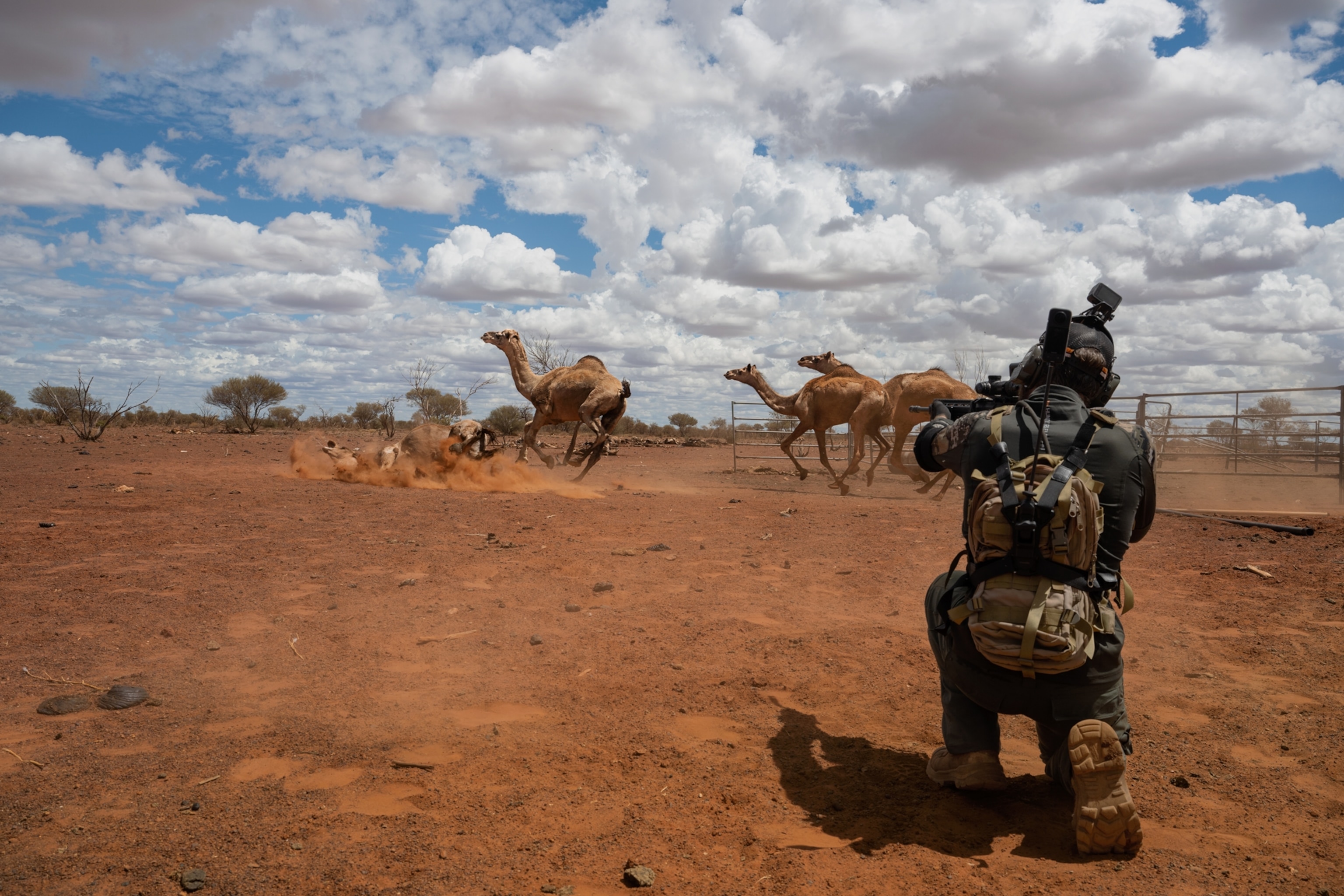
At his cattle ranch in Western Australia, Jack Carmody protects his operation by culling invasive camels himself. Here he uses a rifle to shoot animals that he discovered drinking water designated for his herds. He films scenes like this for his YouTube channel to highlight the severity of the situation.
Australia is now home to the world’s largest feral camel population, with estimates from several hundred thousand to as many as a million. Females can give birth every two years and live up to 40 years in the wild, meaning the number of camels can double every nine years. Weighing an average of 1,000 pounds, they roam in herds from fewer than 10 to several hundred, trampling ecosystems and destroying infrastructure. The creatures are voracious consumers of plants, competing with other wildlife and livestock, and limiting food sources for Aboriginal communities. They destabilize sand dunes, which can lead to erosion. Camels also foul water holes with their droppings or by mobbing them, only to die of thirst, their carcasses poisoning what little water is left.
(Meet the animals that can handle extreme heat.)
Water, in fact, is the source of the biggest problem. When enough moisture-rich plants are available, camels, famously, can subsist for weeks on end without a drink. But when they do get thirsty, they’re insatiable. An adult camel can consume 50 gallons in a day. When natural sources of water dry up on Aboriginal land, pastoral territory, and cattle stations, camels go looking for a drink wherever they can find it. In the process, they often rip up pipes, destroy toilet blocks, and knock airconditioners out of windows.

A monitor lizard strolls by as Carmody works to fix a leaking cattle trough, which could attract camels. In their quest for water, camels have been known to destroy fences, piping, and even air conditioners.
What’s even more concerning is that a rising number of droughts is pushing the animals into ever closer and more frequent contact with humans. One of the most damaging of these conflicts occurred in 2013 on a Northern Territory cattle station named Curtin Springs. Six years earlier, feral camels desperate for a drink wrecked a hundred miles of the station’s fencing. “And I mean just totally destroyed,” says Lyndee Severin, who runs the farm with her family. “Gone.” Replacing the fencing cost about half a million dollars. Ranchers have a legal obligation to remove feral animals on their property; when she saw the camels were back, Severin called the Australian Feral Camel Management Project, which had culled 27,000 camels from the region the previous year. Within 48 hours snipers arrived at the property, and over the next four days they shot 1,700 camels dead from their helicopters.
But the federal camel-culling program, budgeted for four years, ended in 2013, with little political will in cities to keep the distant outback project going. And feral camel numbers have only gone up. According to biologist Tim Low, co-founder of Australia’s Invasive Species Council, a private nonprofit, the current impact of feral camels on farmers and rural Aboriginal Australians is “very substantial.” Costs in damage and control, last estimated at $12 million in 2013, are unknown today. Low and other experts say if they can’t get the population under control, the country’s next droughts will lead to more crises.
There are plenty of ideas, both practical and fanciful, for what to do with the feral camels, but it’s helpful to understand why they were brought to Australia in the first place. In the 1830s, British colonists—struggling to survey the outback on horses that tired easily—got word of camels’ extraordinary endurance. The first camel to enter the country arrived in 1840 from the Canary Islands, and others followed from Arabia, Afghanistan, British India, and the Persian and Ottoman Empires. Colonists also brought in more than 2,000 camel operators, or cameleers, whom they collectively called Afghans despite their disparate origins. Camels helped open the remote interior, transporting food and supplies, as well as gold prospectors and workers building railway and telegraph systems. Then the “white Australia” policy, enacted in 1901 to prevent non-Europeans from immigrating, began to thin the number of cameleers, as would technology. By the 1930s, cars and railroads had rendered Australia’s camel industry all but obsolete. Many foreign cameleers returned to their homelands, and their camels, up to 10,000 of them, suddenly jobless, were set free to roam.
(The sinister reason why camels were brought to the American West.)

Camels like this one, being unloaded at Australia’s Port Augusta circa 1893, once helped British colonists explore the country’s interior and build railroad systems.
State Library of South Australia, B 68916
One traditional use for these wayward animals is to enlist them in the camel trekking industry, which offers a ruggedly authentic way for travelers to see some of the most remote parts of Australia’s interior. Camel trekking was made famous by Robyn Davidson’s 1980 memoir, Tracks, about her solo 1,700-mile journey by camel across the deserts of western Australia, and the industry now comprises a dozen operators. One of the longest running is the Outback Camel Company. Andrew Harper, who has owned the outfit since 2000 and has 21 camels, estimates that fewer than a hundred camels around the country are being used for trekking. “We’re governed by the seasons,” says Harper. And with limited numbers of people wanting to make desert treks, “it’s not like your normal business model [focused on] exponential growth.”
But there’s also a more dramatic way to ride feral camels, one that like the animals themselves has been imported from abroad. Each year, more than 4,000 people visit the Queensland village of Boulia (population under 500), which hosts one of Australia’s most famous camel-racing tournaments, a competition where the purse totals some $30,000. The animals are temperamental: Few heats pass without a buck or a bite, and any jockeys worth their salt have the scars to prove it. “Every single camel has got a different personality,” says jockey Brettlyn “Beaver” Neal. “You hope you get a good start. And, yeah, hold on.”

For some, camel trekking is an ideal way to see the country. Outback Camel Company senior cameleer Rick McNamara (at right) leads an expedition in South Australia’s Strzelecki Desert; ornithologist Boyd Wykes (center) often joins treks to research native wildlife.
Camel trekker Paddy McHugh founded the Boulia Camel Races in 1997. It remains a modest enterprise, as does the entire domestic racing circuit, which has only about a hundred camels in competition. But McHugh thinks that figure could grow tenfold. A Formula One–style circuit could connect Australian races with contests in North Africa and in the Persian Gulf, where racing camels can be worth over a million dollars. In Saudi Arabia, perhaps the sport’s global capital, the 2024 Crown Prince Camel Festival featured more than 21,000 camels and a staggering prize pot of $15 million.
McHugh is a realist, though, and thinks the only way to solve Australia’s camel problem is to market the creature’s varied attributes. “The camel is so underrated,” he says. “We need to lift that profile and make it another great industry for Australia.” Opposed to culling, like some Aboriginal communities and animal welfare groups, he’s upset by the “mindless slaughter” of this “great animal.”

Two female jockeys and their camels wait near the starting line at the Boulia races in Queensland, another outlet for feral camels. Thousands of visitors come to the track each year to watch the often unruly animals reach speeds of up to 40 miles an hour.
Camels are remarkably versatile: Unlike most any other animal that you can race up to 40 miles an hour, they can also be milked. Camel milk, which is creamy and slightly salty, offers a nutritious, low-fat, and low-lactose alternative to cow’s milk. Australia’s camel milk production, 50,000 gallons a year at last available count, is a drop in the proverbial bucket compared with 634 million gallons in cow’s milk sales today. But it’s an emerging cottage industry. The Camel Milk Co., founded north of Melbourne in 2014, now has a milking herd of more than 200 at its dairy. Summer Land Camels, an organic farm in Queensland where 800 camels graze, vaunts the benefits of the vitamin C–rich milk and offers a range of other dairy products, from feta to gelato, body cream to milk vodka. Elsewhere in Queensland, QCamel is producing camel’s milk chocolates.
There are, of course, significant challenges to scaling these operations to such a degree that they could make a dent in the country’s huge feral population. As Warwick Hill of South Australia–based camel dairy Humpalicious explains, animals bred for milking typically have uniform teat and udder sizes. Nobody’s made any serious efforts to breed camels for conformity to machinery, he says. “The time it takes us to milk a dozen camels, a cow dairy could probably be putting through 500.”
You May Also Like
One of Humpalicious’s products, jerky, points toward another potential solution: camel meat, which is a $1.6 billion global enterprise (an industry report projects it will swell to $2.2 billion by 2030), with major markets in the Middle East and Africa. Camel meat is already having a moment. An episode of the new Australian TV show Eat the Invaders urged viewers to try it. Businesses already taking advantage of the demand include artisanal enterprises and large firms such as Samex, a meat exporter in Adelaide, and New South Wales’s Fettayleh Foods, a wholesale and retail meat products supplier for the domestic market that offers camel burger patties.

A drone captures a group of feral camels as they flee Carmody’s shots. The rancher kills hundreds each year, often harvesting the meat for his family. Today there’s an emerging market for camel meat, milk, and skin care products.
Like camel dairy, camel meat is a niche business in Australia: Its camel-meat industry produces a few hundred tons a year, a far cry from the nearly three million tons of beef it produces. But Eddie Hopkins, CEO of Camel Export Australia, says there’s a growing demand abroad for the country’s camel meat, particularly in the United States. He’s fielded requests for more than 25 tons a week—about 200 camels’ worth—from grocers in Minneapolis, Minnesota, home to a large Somali community for whom the animal is a staple source of meat and milk. Hopkins thinks those requests are just “scraping the surface” and believes the actual weekly demand, globally, to be closer to 1,200 camels, making him optimistic about the industry’s long-term prospects.
Carmody, the rancher and YouTuber, also hopes to sell some of the 130 tons of camel meat that his culls could yield annually. In one recent video, he slices off the fatty hump of a dromedary to access the meat underneath it, explaining he sometimes also makes cuts from the legs and shoulders for sausages. But it’s a lot of work, and he wonders whether enough customers will be willing to pay the necessary premium. After all, it’s painstaking and expensive to cull the animals in the desert and transport them for processing. “It’s just horrendously cost prohibitive,” Carmody says, “and it’s cheaper just to shoot them all.”

Carmody checks his phone, reviewing surveillance footage of water sources on his property while his daughter Verety tags along. Camels can survive without water for weeks, but as droughts increase, they will seek out new spots to drink from.
A number of experts agree that a commercial camel-meat industry could never reach the scale needed to solve the problem. Biologist Tim Low, of the Invasive Species Council, argues that focusing on industries that harvest camels will only create resistance to necessary culling, which he sees as the sole practical solution. Carmody, for his part, says he can’t even cull camels efficiently, with semiautomatic weapons, thanks to a statewide ban on the firearms that’s been the subject of several Jack Out The Back videos. “I’m letting everyone know exactly what’s going on and how little we are supported,” he says. “We’re being told that we’re a threat to society if we have access to tools to do the job. But we’re actually doing something we have to do.”
Recently, Carmody was flying up from Australia’s southern coast toward home when, less than an hour into the flight, he spotted a small herd of camels heading toward a farming zone. “It’s not just an out-the-back problem,” he says. “It’s going to start becoming a problem down on the coast.”
But for now, it’s outback cattle stations like Carmody’s and Severin’s that remain at the heart of the crisis. To keep feral camels in check, Severin holds about 50 at a time that she’s rounded up, until they are mature enough to be sold for slaughter. “We don’t like to shoot to waste,” she says. But her patience is wearing thin, and she fears another clash is on the horizon. It’s not “if they’ll come back,” she says. “They will come back.” The real question is what the inhabitants of the outback are prepared to do about it.

Senior cameleer Lucile Leverrier shares a quiet moment with her favorite animal, Claypan, during a trek in the Strzelecki Desert. Fewer than a hundred camels are used in the trekking industry, a fraction of the number running free in the outback.
A version of this story appears in the May 2025 issue of National Geographic magazine.
Based in Wellington, New Zealand, Sean Williams reported on feral camels for his first story for the magazine. His work has appeared in Harper’s, the New Yorker, Wired, Outside, and GQ.












